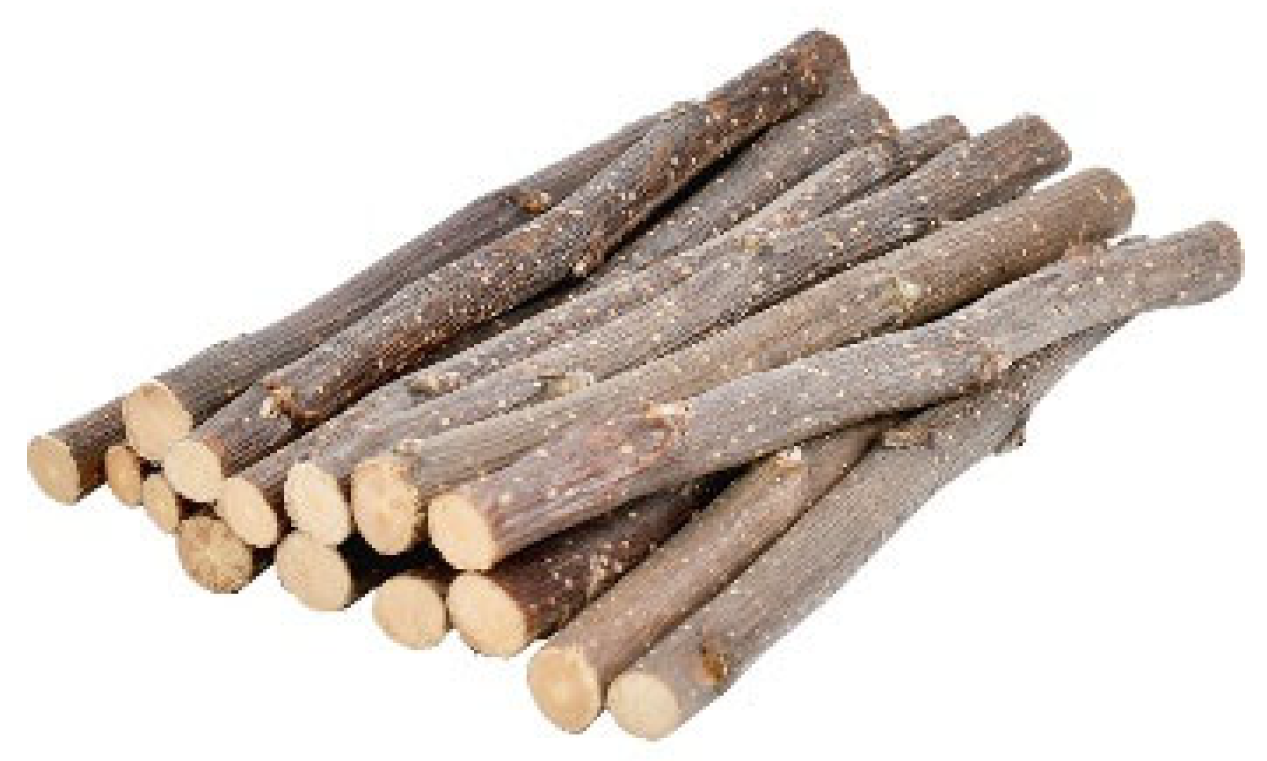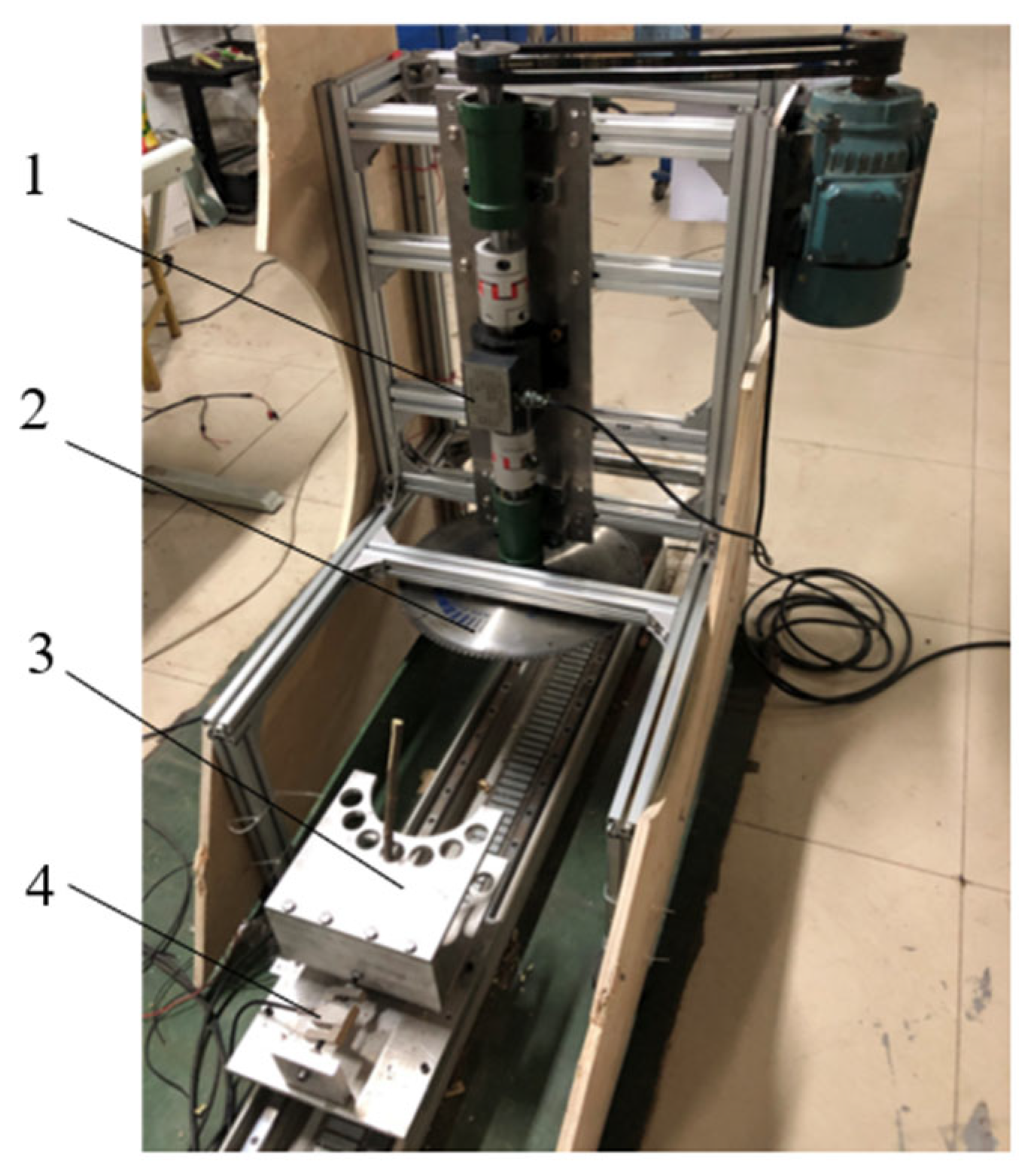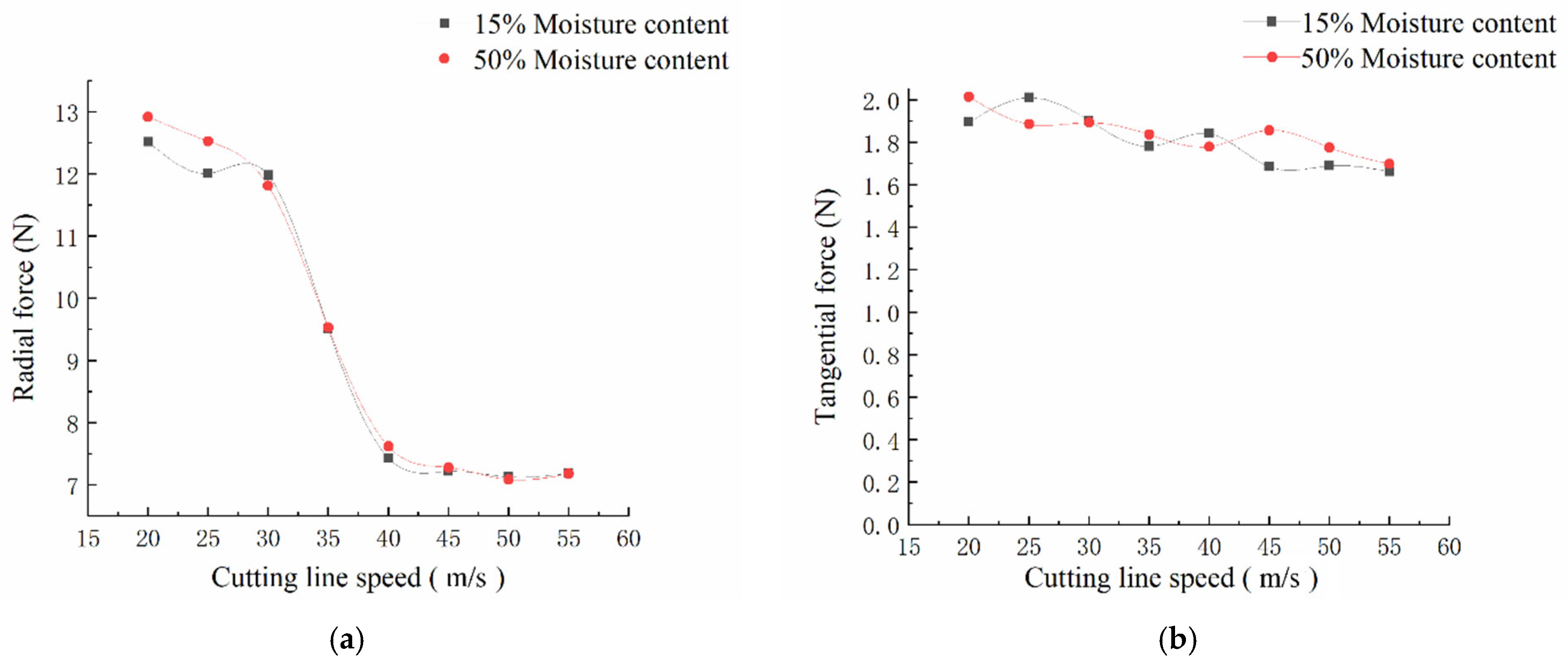Influencing Factors of Cutting Force for Apple Tree Branch Pruning
Abstract
:1. Introduction
2. Materials and Methods
2.1. Test Materials
2.2. Test Equipment
2.3. Cutting Force Experiments
3. Results
3.1. Single Factor Experiment
3.1.1. Cutting Line Speed
3.1.2. Feed Rate
3.1.3. Branch Diameter
3.1.4. Moisture Content
3.2. Statistical Model
+ 0.061 D − 0.0099 Vc2 + 2.98 Vf2
3.3. Verification Test
4. Discussion
5. Conclusions
Author Contributions
Funding
Institutional Review Board Statement
Informed Consent Statement
Data Availability Statement
Acknowledgments
Conflicts of Interest
References
- Kolmanič, S.; Strnad, D.; Kohek, Š.; Benes, B.; Hirst, P.; Žalik, B. An algorithm for automatic dormant tree pruning. Appl. Soft Comput. 2021, 99, 106931. [Google Scholar] [CrossRef]
- Bound, S.A. Managing Crop Load in European Pear (Pyrus communis L.)—A Review. Agriculture 2021, 11, 637. [Google Scholar] [CrossRef]
- Abbood, S.; Abbood, M.; Jasim, A.; Lect, A.; Aldafar, S. Manufacturing and testing of date palm vibration motorized fronds cutter. Iraqi J. Agric. Sci. 2019, 49, 763–773. [Google Scholar]
- Castellanos, L.; Simoni, R.; Martins, D.; Vieira, R. Tree Pruning in Electrical Network: Topic and Fundamentals in Machines and Robots. Rev. Tecnol. Cienc. 2019, 36, 186–201. [Google Scholar] [CrossRef]
- Karkee, M.; Adhikari, B.; Amatya, S.; Zhang, Q. Identification of pruning branches in tall spindle apple trees for automated pruning. Comput. Electron. Agric. 2014, 103, 127–135. [Google Scholar] [CrossRef]
- BoydaŞ, M.; ÇOmakli, M.; Sayinci, B.; Kara, M. Effects of moisture content, internode region, and oblique angle on the mechanical properties of sainfoin stem. Turk. J. Agric. For. 2019, 43, 254–263. [Google Scholar] [CrossRef] [Green Version]
- Igathinathane, C.; Womac, A.R.; Sokhansanj, S. Corn stalk orientation effect on mechanical cutting. Biosyst. Eng. 2010, 107, 97–106. [Google Scholar] [CrossRef]
- Moradpour, P.; Doosthoseini, K.; Scholz, F.; Tarmian, A. Cutting forces in bandsaw processing of oak and beech wood as affected by wood moisture content and cutting directions. Eur. J. Wood Wood Prod. 2013, 71, 747–754. [Google Scholar] [CrossRef]
- Moradpour, P.; Scholz, F.; Doosthoseini, K.; Tarmian, A. Measurement of Wood Cutting Forces during Bandsawing Using Piezoelectric Dynamometer. Drv. Ind. 2016, 67, 79–84. [Google Scholar] [CrossRef] [Green Version]
- Pichler, P.; Leitner, M.; Grün, F.; Guster, C. Evaluation of wood material models for the numerical assessment of cutting forces in chipping processes. Wood Sci. Technol. 2017, 52, 281–294. [Google Scholar] [CrossRef] [Green Version]
- Krenke, T.; Frybort, S.; Müller, U. Cutting force analysis of a linear cutting process of spruce. Wood Mater. Sci. Eng. 2017, 13, 279–285. [Google Scholar] [CrossRef]
- Cai, W.; Zhou, Y.; Jia, S.; Han, H. Study on Mechanical Properties of Apple Branches. J. Anhui Agric. Sci. 2019, 47, 229–231. [Google Scholar]
- Lučić, R.; Goglia, V.; Pervan, S.; Dukić, I.; Risovic, S. The influence of wood moisture content on the process of circular rip-sawing. Part I: Power requirements and specific cutting forces. Wood Res. 2004, 49, 41–49. [Google Scholar]
- Krilek, J.; Kovac, J.; Kucera, M. Wood Crosscutting Process Analysis for Circular Saws. Bioresources 2014, 9, 1417–1429. [Google Scholar] [CrossRef]
- Schmidt, C.; Westermann, H.; Thorenz, B.; Steinhilper, R. Sustainability of cutting frozen wood—An analysis of buzz saw blades cutting performance depending on wood temperature. Procedia Manuf. 2018, 25, 263–270. [Google Scholar] [CrossRef]
- Nasir, V.; Cool, J. Optimal power consumption and surface quality in the circular sawing process of Douglas-fir wood. Eur. J. Wood Wood Prod. 2019, 77, 609–617. [Google Scholar] [CrossRef]
- Abdallah, R.; Auchet, S.; Méausoone, P. A dynamic measurement of a disc chipper cutting forces. Biomass Bioenergy 2014, 64, 269–275. [Google Scholar] [CrossRef]
- Ghahraei, O.; Ahmad, D.; Khalina, A.; Suryanto, H.; Othman, J. Cutting Tests of Kenaf Stems. Trans. Asabe 2011, 54, 51–56. [Google Scholar] [CrossRef]
- Johnson, P.; Clementson, C.; Mathanker, S.; Grift, T.; Hansen, A. Cutting energy characteristics of Miscanthus x giganteus stems with varying oblique angle and cutting speed. Biosyst. Eng. 2012, 112, 42–48. [Google Scholar] [CrossRef]
- Orlowski, K.; Ochrymiuk, T. A newly-developed model for predicting cutting power during wood sawing with circular saw blades. Maderas Cienc. Tecnol. 2017, 19, 149–162. [Google Scholar] [CrossRef] [Green Version]
- Zhao, R.; Wang, H.; Tang, Z.; Zhang, B.; Ye, M. Experiment on influencing factors of power consumption for sawing stem in cutting device of litchi harvester. Trans. Chin. Soc. Agric. Eng. 2016, 32, 16–21. [Google Scholar]
- Li, W.; Zhang, Z.; Luo, B. Effects of sawtooth side edges with different radial clearance angles on the cutting force in wood sawing. Mater. Werkst. 2018, 49, 1468–1475. [Google Scholar] [CrossRef]
- Esgici, R.; Pekitkan, F.; Ozdemir, G.; Güzel, E.; Sessiz, A. Cutting parameters of some grape varieties subject to the diameter and age of canes. Fresenius Environ. Bull. 2019, 28, 167–170. [Google Scholar]
- Kang, F.; Tong, S.; Zhang, H.; Li, W.; Chen, Z.; Zheng, Y. Analysis and experiments of reciprocating cutting parameters for apple tree branches. Trans. Chin. Soc. Agric. Eng. 2020, 36, 9–16. [Google Scholar]
- Du, D.; Wang, J.; Qiu, S. Optimization of cutting position and mode for cabbage harvesting. Trans. Chin. Soc. Agric. Eng. 2014, 30, 34–40. [Google Scholar]
- Wu, L.; Yang, Z.; Duan, J.; Wang, L.; Liu, J. Experiment on influencing factors of cutting force of blades of trim tool for longan branch. Trans. Chin. Soc. Agric. Eng. 2012, 28, 8–14. [Google Scholar]
- Maciak, A.; Kubuśka, M.; Moskalik, T. Instantaneous Cutting Force Variability in Chainsaws. Forests 2018, 9, 660. [Google Scholar] [CrossRef] [Green Version]
- Yang, L.; Chen, J.; Xie, R.; Hua, J.; Kang, M.; Dong, Q. Simulation research for Individual Young Apple Tree Pruning. Trans. Chin. Soc. Agric. Mach. 2015, 46 (Suppl. S1), 41–44. [Google Scholar]
- Ding, S.; Xue, X.; Cai, C.; Cui, L.; Chen, C. Optimization and experiment of blade parameter for pear branches cutting device. Trans. Chin. Soc. Agric. Eng. 2015, 31 (Suppl. S2), 75–82. [Google Scholar]
- Hlásková, L.; Kopecký, Z.; Novák, V. Influence of wood modification on cutting force, specific cutting resistance and fracture parameters during the sawing process using circular sawing machine. Eur. J. Wood Wood Prod. 2020, 78, 1173–1182. [Google Scholar] [CrossRef]







| Parameters | Values |
|---|---|
| Three-phase AC motor Rated rotating speed (r/min) | 2880 |
| Torque sensor range (N·m) | 0~50 |
| Torque sensor measurement accuracy (%) | ≤0.5 |
| Tension-compression sensor range (kg) | 0~10 |
| Tension-compression sensor measurement accuracy (%) | ≤0.03 |
| Acquisition frequency of oscilloscope (Hz) | 1000 |
| Branch Diameter (mm) | Cutting Line Speed (m/s) | Feed Rate (m/s) | Cutting Force (N) |
|---|---|---|---|
| −1 | 0 | 1 | 18.01 |
| 0 | 0 | 0 | 8.16 |
| 0 | 1 | −1 | 6.16 |
| −1 | −1 | 0 | 11.5 |
| 0 | 1 | 1 | 9.07 |
| 1 | 1 | 0 | 6.47 |
| 0 | −1 | 1 | 10.09 |
| 0 | 0 | 0 | 7.64 |
| −1 | 1 | 0 | 10.52 |
| 0 | 0 | 0 | 8.48 |
| 0 | −1 | −1 | 4.58 |
| 1 | −1 | 0 | 6.45 |
| 0 | −0 | 0 | 8.37 |
| 1 | 0 | 1 | 7.63 |
| −1 | 0 | −1 | 9.01 |
| 1 | 0 | −1 | 5.32 |
| Sum of Squares | Freedom | Mean Square | F Value | Significant Level (p) | |
|---|---|---|---|---|---|
| Model | 142.61 | 9 | 15.85 | 22.82 | 0.0002 |
| Vc | 67.11 | 1 | 67.11 | 96.66 | <0.0001 |
| Vf | 0.02 | 1 | 0.02 | 0.029 | 0.87 |
| D | 48.66 | 1 | 48.66 | 70.09 | <0.0001 |
| VcVf | 0.25 | 1 | 0.25 | 0.36 | 0.5674 |
| VcD | 11.19 | 1 | 11.19 | 16.12 | 0.0051 |
| VfD | 1.69 | 1 | 1.69 | 2.43 | 0.1627 |
| Vc2 | 9.83 | 1 | 9.83 | 14.16 | 0.007 |
| Vf2 | 4.12 | 1 | 4.12 | 5.94 | 0.045 |
| D2 | 0.3 | 1 | 0.3 | 0.44 | 0.53 |
| Residual | 4.86 | 1 | 0.69 | ||
| Lack of Fit | 4.42 | 7 | 1.47 | 13.42 | 0.0149 |
| Total | 147.47 | 16 |
| Branch Diameter (mm) | Cutting Line Speed (m/s) | Feed Rate (m/s) | Prediction of Cutting Force (N) | Measured Cutting Force (N) | Error (%) |
|---|---|---|---|---|---|
| 15 | 30 | 0.6 | 11.93 | 11.5 | 3.7 |
| 15 | 40 | 0.3 | 8.75 | 9.01 | 2.9 |
| 20 | 40 | 0.6 | 8.2 | 8.48 | 3.4 |
Publisher’s Note: MDPI stays neutral with regard to jurisdictional claims in published maps and institutional affiliations. |
© 2022 by the authors. Licensee MDPI, Basel, Switzerland. This article is an open access article distributed under the terms and conditions of the Creative Commons Attribution (CC BY) license (https://creativecommons.org/licenses/by/4.0/).
Share and Cite
Li, C.; Zhang, H.; Wang, Q.; Chen, Z. Influencing Factors of Cutting Force for Apple Tree Branch Pruning. Agriculture 2022, 12, 312. https://doi.org/10.3390/agriculture12020312
Li C, Zhang H, Wang Q, Chen Z. Influencing Factors of Cutting Force for Apple Tree Branch Pruning. Agriculture. 2022; 12(2):312. https://doi.org/10.3390/agriculture12020312
Chicago/Turabian StyleLi, Chengjun, Hanshi Zhang, Qingchun Wang, and Zhongjia Chen. 2022. "Influencing Factors of Cutting Force for Apple Tree Branch Pruning" Agriculture 12, no. 2: 312. https://doi.org/10.3390/agriculture12020312
APA StyleLi, C., Zhang, H., Wang, Q., & Chen, Z. (2022). Influencing Factors of Cutting Force for Apple Tree Branch Pruning. Agriculture, 12(2), 312. https://doi.org/10.3390/agriculture12020312





